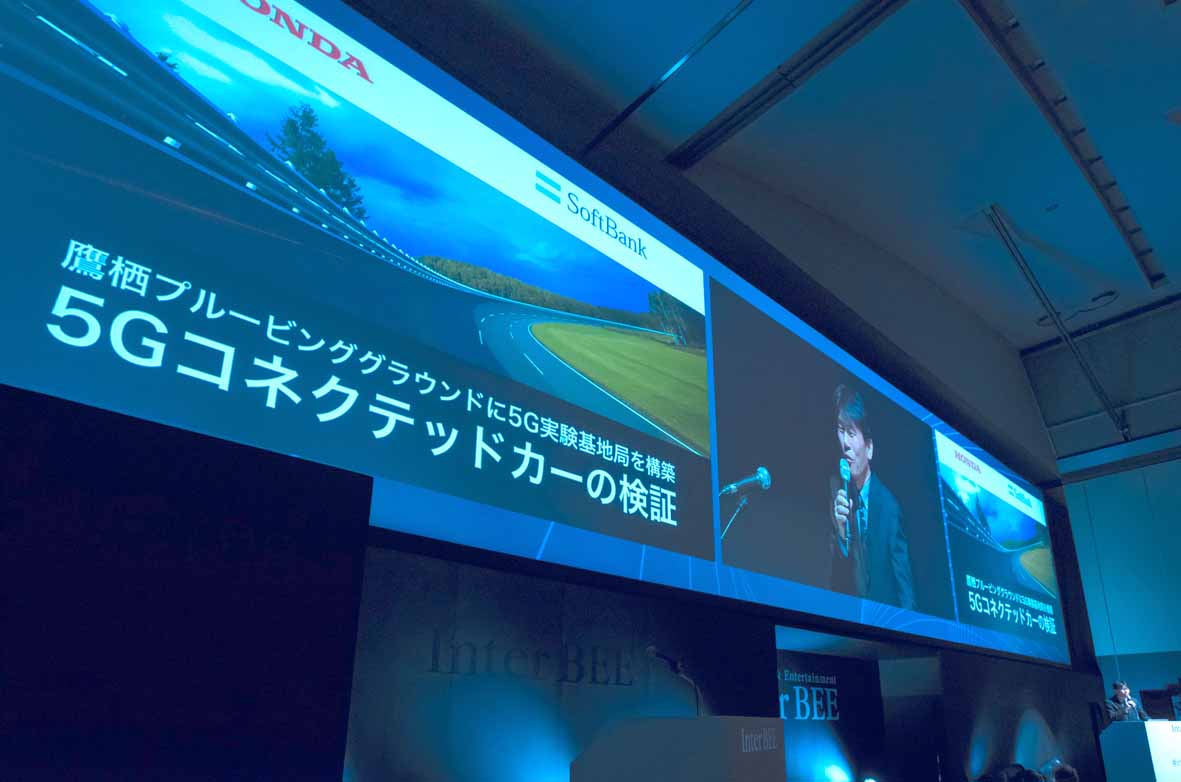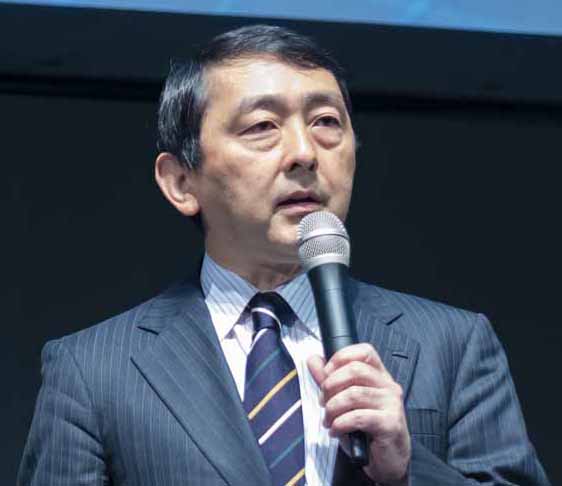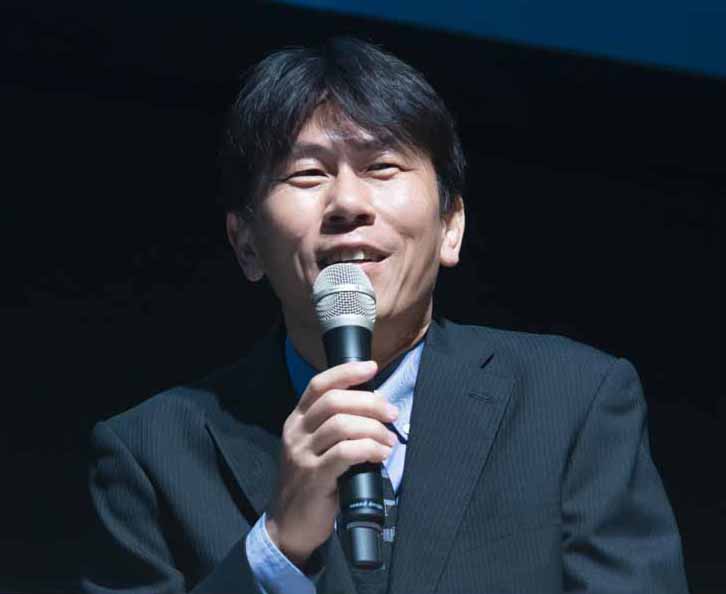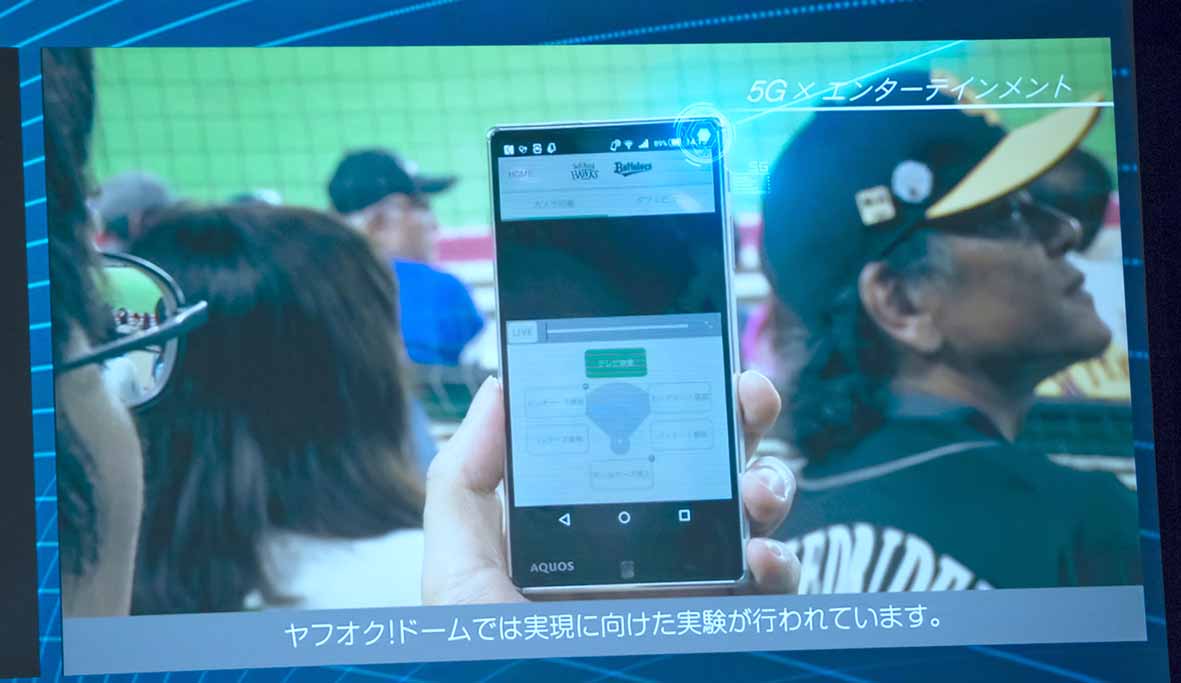Inter BEE 2018: Main three carriers describe new integration between 5G video and communications
2019.2.24 UP

The term “5G” is increasingly being mentioned in various industries. 5G refers to the “fifth generation” mobile telecommunications system that would replace the current LTE (4G). 5G offers ultra high-speed and high-capacity telecommunications, ultra low latency, and support for multiple device connections, which would make it possible to achieve many new applications that LTE thus far has been unable to provide. In Japan, 5G is in a pre-service phase in 2019. Just what impact is it having on the video and content creation industries?
At the Mobile World Congress, held from February 25 to 28 in Spain, telecommunications operators from the world over gathered to exhibit their 5G, AI, and IoT solutions and host various sessions. Inter BEE 2018’s keynote speech, “5G Session 2018,” held in November of last year, featured talks from Japan’s three main telecommunications operators. They discussed the current realities of 5G and its future outlook, as well as showcased specific trials and pilots underway in the country. One aspect of interest is the way in which all three of these firms are focusing on joint development with their partners.
The lecture showcased a range of examples describing what potential 5G has to offer the content businesses. It was a valuable opportunity that suggested ideas for how content creators can take their businesses in a new direction. As we approach 2019, when 5G will begin in earnest, we discuss in detail what these talks covered.
■Progress each decade: the diversification of telecommunications
“Mobile telecommunications makes major advances about every decade. The next evolution following 4G will be 5G.” Yukihiko Okumura, chief engineer at NTT DoCoMo’s 5G Innovation Promotion Group, began his talk by discussing the company’s Sedai (Generation) mobile telecommunications system. Okumura described the high speed offered by 5G, saying, “NTT DoCoMo’s current LTE (LTE-Advanced, a form of 4G) offers service at up to 988Mbps. Over the last twenty-five years, this is a 400,000-fold improvement in speed. 5G is already quite high speed, so we expect it to reach a peak of 20Gbps.” In a connected car trial by NTT DoCoMo, 11Gbps was achieved when traveling at a velocity of 30km/h, and 8Gbps when traveling at 100km/h. At 290km/h, which approaches bullet train speeds, communication was 1.1Gbps; this implies that they succeeded in the handover between different base stations.
However, 5G’s goal is not merely achieving high-speed broadband communications. Okumura said, “The low latency it offers allows for smooth transmission of data, reaching under 1ms over wireless. It also lets you connect multiple devices, such as those used in IoT (Internet of things).” The goal is to utilize these three benefits to provide new value and solve social issues. The company is already pursuing trials with partner firms, such as 4K video used for remote diagnostics, and the low latency and high fidelity communications being used for remote manipulation of construction machinery in real time.
■5G: providing infrastructure to solve social issues and enhance corporate value
Akira Matsunaga, Senior Director of the KDDI Technology Group’s Technology Division, Mobile Technology Group, noted that 5G, as a brand-new technology, has the potential to change the experiences end-users have with technology. “At KDDI, we want to provide exciting new experiences possible only through 5G. To that end, we want to achieve things in four different categories. The first is using 5G to solve social issues associated with a declining population and regional disparity. Users could remotely manipulate construction machinery or use drones and IoT. This would cope with the labor shortage. Secondly, we want to resolve regional dilemmas and bolster the economies of those places. One project we are trialing is using 5G to transmit high fidelity 4K video to remotely supervise sake production at a local brewery.”
Another benefit Matsunaga mentioned was providing new experiences. In other words, 5G would play a pivotal role in providing exciting, new experiences for the end-user. This high-speed, high-capacity communications technology would bring more possibilities for video, such as robot experiences that make use of its low latency, or better stadium entertainment. Matsunaga said they have engaged in successful trials of applications to a range of industries. The fourth and final benefit he described was digital transformation (DX); KDDI is pursuing joint development with its partners and with startups bringing new ideas to the table.
Takashi Okamawari, of SoftBank’s Advanced Technology Development Group, said, “3G was a network catering to telephones and voice audio. 4G is a data network for smartphones. 5G will become a network for the provision of new services.” “This means networking not just for end-users, but also for objects and devices, leading from networking for smartphones to more advanced infrastructure for society.” 5G taps into a higher frequency than prevailing methods. This offers access to a wider bandwidth than 4G, but the limited experience carriers have in this realm will require more review and testing. “To that end, we have been running field trials for two years, including now in urban areas,” said Okamawari.
The mobile stations (i.e., devices) we were using at the time involved packing a van full of equipment. But today, devices have become smaller and smaller. In 2018, the Daimon area of Minato-ku, Tokyo, a typical urban zone in the city, was used to install three 5G base stations for a field trial that aimed to cover the entire area using multiple stations. In addition to a handover test, throughput was confirmed to reach 2Gbps on the downlink and 360Mbps on the uplink -- in other words, high-speed transmission. “SoftBank’s implementation of 5G is already ready on the technical end, and we are now exploring how to use this to solve social and industry issues. In terms of 5G for vehicles, we have demonstrated its performance in the realm of V2X (communication between vehicles and devices), controlling banks of trucks by 5G, and more. We provide services over 4G for IoT and are exploring new ways of using 5G there for infrastructural surveillance of highways, smart offices, et cetera.” (Okumura)
■5G will transform everything from sporting events to virtual reality video
The ultra high speed and ultra low latency offered by 5G will usher in major changes to applications involving video. While trials are still in their basic stages, NTT DoCoMo states that they have “succeeded at video uplink of high framerate 4K over 5G from vehicles moving at 200km/h.” (Okumura) This would offer new potential for video, such as broadcasting hi-fi live views from fast-moving racecars or bullet trains in real time. NTT DoCoMo, in a trial of video broadcast over 5G, confirmed that this high-speed solution allows for broadcasting 8K to up to 12 channels simultaneously. Okumura said, “By addressing and revising issues not just in the wireless layer, but in the application layer, we have demonstrated the potential for multichannel broadcasts of 8K video even over mobile.”
They are also exploring new ways of watching sports, such as combining multi-channel video and IoT. Okumura added, “In partnership with Fuji TV, we have combined 5G and AR (augmented reality) to create Jiosuta (a portamanteau of “diorama” and “stadium”), a virtual diorama sports viewing solution. In applications involving automobile races on circuits, we can allow user to select an angle of the track or the racer’s-eye view, as well as display AR information including real-time driver data like speed, engine RPM, and even the driver’s muscle data, which uses Hitoe, a wearable biometric sensor. This could be used at sports bars to offer new entertainment experiences.” This solution leverages 5G’s high speed, low latency, and ability to connect multiple IoT devices.
KDDI is also performing trials that revolve around the use of 5G as a high-speed, low latency video solution. One of these is what is referred to as telexistence. This allows for a user to remotely manipulate a robot and seeing/touching it as though it actually existed. “We are partnering with Telexistence, which develops robots for telexistence applications, to create a prototype, which we demoed in September 2018. Users could manipulate a robot located remotely in Ogasawara, allowing them to feel as though they were actually there.” (Matsunaga) In this way, transmission of high-definition images and data, such as haptic data, at low latency offers possibilities for new content revolving around more realistic virtual experiences.
A slightly more realistic solution would be the use of 5G for stadium entertainment. KDDI has built a 5G area at the Okinawa Cellular Stadium in Naha. 16 4K cameras are installed around the stadium, with 50 5G tablet devices being used to stream different content. This system makes use of the 28GHz bandwidth, a high frequency. Matsunaga said, “In June of 2018, we posted progress with a test using multiple tablet devices to show different angles of video at a professional baseball game. The tablets broadcast different angles of the field and each received their own stream. 5G allowed for users to select a camera angle of their choice with generally no latency. This has major potential to enhance the way we watch sports.”
In addition to the above, the company is exploring new integrations between video and 5G. At the Ito En Ladies Golf Tournament, 5G was used for real-time broadcasting of super slow 4K video, and the high speed of uplink suggested new possibilities for video applications. Drones were also used over 5G to beam real-time 4K video showing the live scene from the sky.
■What 5G needs: not just better performance, but enhanced end-to-end
SoftBank’s Okamawari acknowledge the possibilities 5G has to offer in terms of video and entertainment, but also pointed out some issues. He explained: “At SoftBank, we have renovated part of our lab in Odaiba and have turned it into a studio at which our corporate clients can experience 5G for themselves. For example, we can connect 360 degree cameras to a 5G network to send VR content. Replacing HDMI and coaxial cables with 5G lets you transmit high-fidelity video, but making this viable at two separate locations presents challenges. This is the main concern I would point out.”
One context would be sending 4K video transmissions with 5G. 4K video data could be transmitted over a 5G network, then replaying the 4K in a different location. 5G networks allow for transmitting 10Gbps data with 1ms latency. Given that 4K cameras produce 12Gbps data, codecs are needed to compress the data before passing it over 5G. “5G has 1ms latency and may not seem to be any different over traditional cable, but given compression, codecs currently have closer to 100ms latency. With 5G, even if the technology has better performance, codecs and other processing delays affect end-to-end latency. If we really want to achieve low latency end-to-end transmissions, we will need to continue testing the technology,” said Okamawari.
In this way, tests to review end-to-end performance will become indispensable in assessing what potential 5G has to offer in terms of new video applications. SoftBank states that this will hinge on edge and core architectures, so they want to leverage the power of ARM and NVIDIA processors in which they have invested. Utilizing the SoftBank group’s ecosystem, which goes beyond just a telecommunications infrastructure, would allow for helping optimize end-to-end solutions.
All three firms stated that they are working closely with their partners to jointly develop solutions making use of 5G. Likely the faster route to having more stakeholders appreciate the potential of 5G and venture into new challenges with video would be their participating in the partner programs the three firms are rolling out towards joint development of 5G solutions. 5G is offered in a pre-service phase in 2019 and is slated for a full-scale service launch in 2020. Experiencing this technology as soon as possible may allow enterprise operators to explore future possibilities for their video and content businesses.
Inter BEE 2019 opens application period for exhibitors
Inter BEE 2019, the professional expo dedicated to audio, video, and telecommunications, will be held from November 13-15 at the Makuhari Messe (Mihama-ku, Chiba). The event is accepting applications to exhibit starting March 1. The first deadline for applications is May 31, and the second is June 28.











